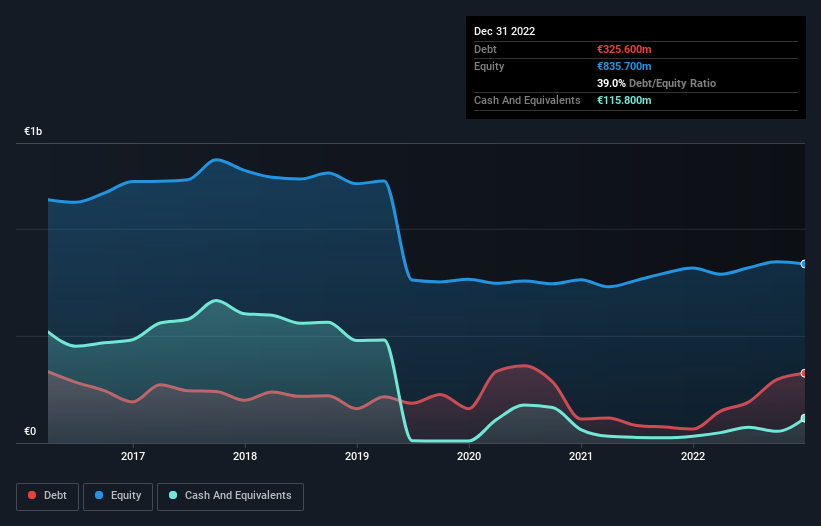
David Iben put it well when he said, 'Volatility is not a risk we care about. What we care about is avoiding the permanent loss of capital.' When we think about how risky a company is, we always like to look at its use of debt, since debt overload can lead to ruin. Importantly, Fiskars Oyj Abp (HEL:FSKRS) does carry debt. But is this debt a concern to shareholders?
Why Does Debt Bring Risk?
Generally speaking, debt only becomes a real problem when a company can't easily pay it off, either by raising capital or with its own cash flow. In the worst case scenario, a company can go bankrupt if it cannot pay its creditors. However, a more frequent (but still costly) occurrence is where a company must issue shares at bargain-basement prices, permanently diluting shareholders, just to shore up its balance sheet. Of course, the upside of debt is that it often represents cheap capital, especially when it replaces dilution in a company with the ability to reinvest at high rates of return. When we think about a company's use of debt, we first look at cash and debt together.
See our latest analysis for Fiskars Oyj Abp
How Much Debt Does Fiskars Oyj Abp Carry?
You can click the graphic below for the historical numbers, but it shows that as of December 2022 Fiskars Oyj Abp had €325.6m of debt, an increase on €65.1m, over one year. However, it does have €115.8m in cash offsetting this, leading to net debt of about €209.8m.

How Strong Is Fiskars Oyj Abp's Balance Sheet?
Zooming in on the latest balance sheet data, we can see that Fiskars Oyj Abp had liabilities of €474.6m due within 12 months and liabilities of €275.1m due beyond that. Offsetting this, it had €115.8m in cash and €184.4m in receivables that were due within 12 months. So it has liabilities totalling €449.5m more than its cash and near-term receivables, combined.
While this might seem like a lot, it is not so bad since Fiskars Oyj Abp has a market capitalization of €1.35b, and so it could probably strengthen its balance sheet by raising capital if it needed to. However, it is still worthwhile taking a close look at its ability to pay off debt.
In order to size up a company's debt relative to its earnings, we calculate its net debt divided by its earnings before interest, tax, depreciation, and amortization (EBITDA) and its earnings before interest and tax (EBIT) divided by its interest expense (its interest cover). The advantage of this approach is that we take into account both the absolute quantum of debt (with net debt to EBITDA) and the actual interest expenses associated with that debt (with its interest cover ratio).
Fiskars Oyj Abp's net debt is only 1.4 times its EBITDA. And its EBIT easily covers its interest expense, being 18.5 times the size. So we're pretty relaxed about its super-conservative use of debt. But the other side of the story is that Fiskars Oyj Abp saw its EBIT decline by 7.3% over the last year. That sort of decline, if sustained, will obviously make debt harder to handle. The balance sheet is clearly the area to focus on when you are analysing debt. But ultimately the future profitability of the business will decide if Fiskars Oyj Abp can strengthen its balance sheet over time. So if you're focused on the future you can check out this free report showing analyst profit forecasts.
Finally, while the tax-man may adore accounting profits, lenders only accept cold hard cash. So we always check how much of that EBIT is translated into free cash flow. In the last three years, Fiskars Oyj Abp's free cash flow amounted to 40% of its EBIT, less than we'd expect. That weak cash conversion makes it more difficult to handle indebtedness.
Our View
When it comes to the balance sheet, the standout positive for Fiskars Oyj Abp was the fact that it seems able to cover its interest expense with its EBIT confidently. But the other factors we noted above weren't so encouraging. For example, its EBIT growth rate makes us a little nervous about its debt. Looking at all this data makes us feel a little cautious about Fiskars Oyj Abp's debt levels. While we appreciate debt can enhance returns on equity, we'd suggest that shareholders keep close watch on its debt levels, lest they increase. The balance sheet is clearly the area to focus on when you are analysing debt. But ultimately, every company can contain risks that exist outside of the balance sheet. These risks can be hard to spot. Every company has them, and we've spotted 2 warning signs for Fiskars Oyj Abp (of which 1 is a bit concerning!) you should know about.
If you're interested in investing in businesses that can grow profits without the burden of debt, then check out this free list of growing businesses that have net cash on the balance sheet.
New: AI Stock Screener & Alerts
Our new AI Stock Screener scans the market every day to uncover opportunities.
• Dividend Powerhouses (3%+ Yield)
• Undervalued Small Caps with Insider Buying
• High growth Tech and AI Companies
Or build your own from over 50 metrics.
Have feedback on this article? Concerned about the content? Get in touch with us directly. Alternatively, email editorial-team (at) simplywallst.com.
This article by Simply Wall St is general in nature. We provide commentary based on historical data and analyst forecasts only using an unbiased methodology and our articles are not intended to be financial advice. It does not constitute a recommendation to buy or sell any stock, and does not take account of your objectives, or your financial situation. We aim to bring you long-term focused analysis driven by fundamental data. Note that our analysis may not factor in the latest price-sensitive company announcements or qualitative material. Simply Wall St has no position in any stocks mentioned.
About HLSE:FSKRS
Fiskars Oyj Abp
Manufactures and markets consumer products for indoor and outdoor living in Europe, the Americas, and the Asia Pacific.
Moderate growth potential low.
Similar Companies
Market Insights
Community Narratives




